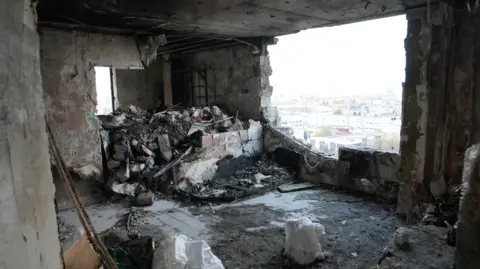
 Facebook/Maria Troyanivska
Facebook/Maria TroyanivskaMaria Troyanivska had come home early the night a Russian drone hit her bedroom.
“It flew in through the window, right into her room,” her mother Viktoria tells the BBC. After the explosion, she and her husband Volodymyr ran from the next room to find their daughter’s room on fire.
“We tried to put it out, but everything was burning so strongly,” she says through tears. “It was impossible to breathe – we had to leave.”
The Russian Shahed drone killed the 14-year-old in her bed, in her suburban apartment in Kyiv, last month.
“She died immediately, and then burned,” her mother said. “We had to bury her in a closed coffin. She had no chance of surviving.”
 BBC/Kamil Dayan Khan
BBC/Kamil Dayan KhanRussia is massively increasing drone strikes on Ukraine. More than 2,000 were launched in October, according to Ukraine’s general staff – a record number in this war.
The same report says Russia fired 1,410 drones in September, and 818 in August – compared with around 1,100 for the entire three-month period before that.
It’s part of a wider resurgence for Russian forces. The invaders are advancing all along the front lines. North Korean troops have joined the war on Moscow’s side. And with the election of Donald Trump for a second term as US president, Ukraine’s depleted and war-weary forces are facing uncertain support from their biggest military donor.
The majority of the Russian drones raining down on Ukraine are Iranian-designed Shaheds: propeller-driven, with a distinctive wing shape and a deadly warhead packed into the nose cone.
Russia has also started to launch fake drones, without any explosives, to confuse Ukraine’s air defence units and force them to waste ammunition.
Compared to missiles they are much cheaper to build, easier to fire, and designed to sap morale.
Every night, Ukrainians go to sleep to notifications pinging on their phones, as inbound drones crisscross the country, setting sirens blaring.
And every morning, they wake to news of yet another strike. Just since the start of November, drones have hit Kyiv, Kharkiv, Odesa, Mykolaiv and Zaporizhzhia.
On Sunday, Russia launched 145 drones at Ukraine, according to President Volodymyr Zelensky – a record number for a single day since the start of the full-scale invasion.
Kyiv said that day it had managed to shoot down 62 drones, and that a further 67 were “lost” – meaning they were either downed by electronic warfare, or disappeared from radar screens.
Ukrainian air defences are struggling to cope with the surging numbers.
“So far we have been intercepting them. I hope we will keep intercepting them,” Sgt Mykhailo Shamanov, a spokesperson for Kyiv city military administration, told the BBC.
While he says Russia tries to hit military installations, the “general aim is terrorising civilians”.
They know the Russians will continue to ramp up these attacks, he said – it’s why his government is constantly asking for more air defence from Western allies.
It’s also why Ukraine is nervously waiting to see how US President-elect Trump will approach the war when he re-enters office.
“Even if air defence works well, drone or missile debris falls on the city. It causes fires, damage and unfortunately sometimes victims,” he explained.
“Every night it’s a lottery – where it hits, where it’s shot down, where it falls and what happens.”
 BBC/Kamil Dayan Khan
BBC/Kamil Dayan KhanVitaliy and his men have no fixed post – their weaponry for shooting down the Shaheds is carried on the back of a flatbed truck, allowing them to manoeuvre quickly.
“We try to monitor, move, outpace the drone, destroy it,” he said.
It’s clear the job is taking its toll.
“Half a year ago, it was 50 drones a month. Now the number has risen to 100 drones, every night,” he said.
Their days are getting longer too. When the Russians used mainly missiles to bomb Ukraine, the unit commander said, the air alerts would last about six hours. “Now, it’s around 12 or 13 hours,” he said.
Vitaliy is confident in front of his men, declaring that they can handle all that the Russians can fire at them if they get weapons from Western allies. “Our guys could even deal with 250 drones [in a night],” he said.
But air defence can only do so much. Ukrainians will continue to suffer until Russia stops its invasion and its air assaults on cities.
Viktoria says their lives are now divided into before and after their daughter’s death. They are staying with a friend after the destruction of their flat; she said they sleep in the corridor at night to shelter from the constant drone attacks.
 BBC/Kamil Dayan Khan
BBC/Kamil Dayan Khan“Of course it’s exhausting,” she said. “But it seems to me it makes people even more angry, irritates and outrages them. Because people really cannot understand, especially lately, those attacks that hit peaceful houses.”
“I don’t understand at all why this war started and for what,” Maria’s father, Volodymyr, told the BBC. “What sense does it make? Not from an economic perspective, nor human, territorial – people just die.”
“It’s just some ambitions of sick people.”
Additional reporting by Hanna Chornous and Anastasiia Levchenko

